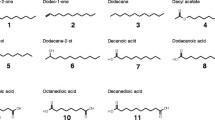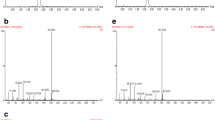Abstract
In a limited screening 65 microorganisms were tested with regard to their ability to reduce keto acids or esters of different chain length and position of the keto group with NADH or NADPH as coenzymes. Twenty-seven organisms exhibited reductase activity. Among these, Candida parapsilosis and Rhodococcus erythropolis have been chosen for further investigation. The keto ester reductases of both C. parapsilosis and R. erythropolis prefer NADH as coenzyme and show higher activity towards keto esters than keto acids. The keto ester reductase production of C. parapsilosis during growth passed a maximum in the late exponential phase, decreased and reaches a plateau in the stationary phase. In contrast, the specific activity of the keto ester reductase of R. erythropolis did not decrease in the stationary growth phase. The enzyme of C. parapsilosis was inducible by a keto ester when growing on glycerol as the sole carbon source. Furthermore, the enzyme of C. parapsilosis was subject to catabolite repression. When C. parapsilosis and R. erythropolis were cultivated on n-alcane the specific activity of their keto ester reductases was enhanced about seven- and eightfold, respectively, compared to growth on glucose. This leads to the assumption that, while growing on n-alcane, a degradation product is formed in both strains that induces the production of the keto ester reductase.
Similar content being viewed by others
References
Bradford MM (1976) A rapid and sensitive method for the quantitation of microgram quantities of protein utilizing the principle of protein-dye binding. Anal Biochem 72:248–254
Caubet R, Guerin B, Guerin MG (1988) Comparative studies on the glycolytic and hexose monophosphate pathway in Candida parapsilosis and Saccharomyces cerevisiae. Arch Microbiol 149:324–329
Chenault HK, Whitesides GM (1987) Regeneration of nicotinamide cofactors for use in organic synthesis. Appl Biochem Biotechnol 14:147–197
Chenault HK, Simon ES, Whitesides GM (1988) Cofactor regeneration for enzyme-Catalysed synthesis. Biotechnol Genet Eng Rev 6:221–267
Chiba T, Nagatsuma M, Nakai T (1985) A facile, stereocontrolled entry to key intermediates for thienamycin synthesis from ethyl (S)-3-hydroxybutanoate. Chem Lett 1343–1346
Christen M, Crout DHG (1987) Enzymatic reduction of beta-Ketoesters using immobilised yeasts. In: Moody GW (ed) Bioreactors and Biotransformations (Gleneagles, Scottland). Elsevier Applied Science, London, pp 213–218
Doi Y (1990) Microbial Polyesters. VCH, Weinheim
Ehrler J, Giovannini F, Lamatsch B, Seebach D (1986) Stereoselectivity of yeast reductions — an improved procedure for the preparation of ethyl (S)-3-hydroxybutanoate and (S)-2-hydroxymethylbutanoate. Chimia 40:172–173
Francke A (1965) The reduction of 5-oxodecanoic acid by normal baker's yeast. Biochem J 95:633–640
Fujisawa T, Itoh T, Sato T (1984) Enantiospecific synthesis of optically pure (3S)-hydroxy esters by the stereocontrolled yeast reduction of α-sulfenyl-β-ketoesters. Tetrahedron Lett 25:5083–5086
Furuichi A, Akita H, Matsukura H, Oishi T, Horikoshi K (1985) Purification and properties of an asymmetric reduction enzyme of 2-methyl-3-oxobutyrate in baker's yeast. Agric Biol Chem 49:2563–2570
Furuichi A, Akita H, Matsukura H, Oishi T, Horikoshi K (1987) Purification and properties of an asymmetric reduction of diethyl 2-methyl-3-oxosuccinate in Saccharomyces fermentati. Agric Biol Chem 51:293–299
Georg GI, Kant J (1988) An asymmetric synthesis of carbapenem antibiotic (+)-PS-5 from ethyl 3-hydroxybutanoate. J Org Chem 53:692–695
Gessner M, Günther C, Mosandl A (1987) Stereoisomere Aromastoffe XIX: Asymmetrische Reduktion von 4(5). Oxocarbonsäuren mit Bäckerhefe. Z Naturforsch Sect C Biosci 42:1159–1164
Graf W (1985) Chiral intermediates as building blocks. In: Tramper J, Plas HC van der, Linko P (eds) Biocatalysts in organic syntheses. vol 22. Elsevier, Amsterdam, pp 41–58
Guerin MG, Camougrand NM, Velours G, Guerin B (1982) New mutants resistant to glucose repression affected in the regulation of the NADH reoxidation. Eur J Biochem 124:457–463
Hirama M, Uei M (1982) Chiral total synthesis of compactin. J Am Chem Soc 104:4251–4253
Hummel W, Kula MR (1989a) Dehydrogenases for the synthesis of chiral compounds. Eur J Biochem 184:1–13
Hummel W, Kula MR (1989b) Simple method for small-scale disruption of bacteria and yeasts. J Microbiol Methods 9:201–209
Itoh T, Sato T, Fujisawa T (1987) Stereocontrol by the introduction of a sulfur functional group in the asymmetric reduction of β-keto esters with baker's yeast. J Chem Soc Jpn 7:1414–1423
König WA, Krebber R, Mischnick-Lübbecke P (1988) Cyclodextrins as chiral stationary phases in capillary gas chromatography. Part V: octakis(3-O-butyryl-2,6-O-pentyl)-γ-cyclodextrin. J High Resolut Chromatogr Chromatogr Commun 12:732–738
Kretschmer A, Wagner F (1983) Characterisation of biosynthetic intermediates of trehalosedicorynomycolates from Rhodococcus erythropolis grown on n-alcanes. Biochim Biophys Acta 753:306–313
Manzocchi A, Casati R, Fiecchi A, Santaniello E (1987) Studies on the stereochemical control of fermenting baker's yeast mediated reductions: some 3-and 4-oxo esters. J Chem Soc Perkin Trans I:2753–2757
Mori K (1989) Synthesis of optically active pheromones. Tetrahedron 45:3233–3298
Mori K, Sugai T (1983) Applications of microorganisms and enzymes in the syntheses of natural products. J Syn Org Chem Jpn 41:1044–1053
Nakamura K, Higaki M, Ushio K, Oka S, Ohno A (1985) Stereochemical control of microbial reduction. 2. reduction of β-keto esters by immobilized baker's yeast. Tetrahedron Lett 26:4213–4216
Nakamura K, Inoue K, Ushio K, Oka S, Ohno A (1987) Effect of allyl alcohol on reduction of β-keto esters by baker's yeast. Chem Letts 679–682
Nassenstein A, Hemberger J, Schwartz H, Kula MR (1992) Studies on the enzymatic reduction of N-Boc-4S-amino-3-oxo-5-phenylpentanoic acid methyl ester. J Biotechnol (in press)
Oguni N, Ohkawa Y (1988) Complete stereoselective synthesis of chiral intermediates for thienamycin and related antibiotics. J Chem Soc Chem Commun 1376–1377
Sallis PJ, Armfield SJ, Bull AT, Hardman DJ (1990) Isolation and characterisation of a haloalkane halidohydrolase from Rhodococcus erythropolis Y 2. J Gen Microbiol 136:115–120
Seebach D, Züger MF (1982) Über die Depolymerisierung von Poly-(R)-3-hydroxy-buttersäureester (PHB). Helv Chim Acta 65:495–503
Seebach D, Züger MF, Giovannini F, Sonnleitner B, Fiechter A (1984) Preparative microbial reduction of β-oxoesters with Thermoanaerobium brockii. Angew Chem Int Ed Engl 23:151–152
Shieh WR (1987) Purification and studies on the β-keto ester reductases from baker's yeast. Thesis. Univ. Microfilms, Int. Order No. DA 8712440
Shieh WR, Gopalan AS, Sih CJ (1985) Stereochemical control of yeast reductions. 5. characterization of the oxidoreductases involved in the reduction of β-keto esters. J Am Chem Soc 107:2993–2994
Shimizu S, Kataoka M, Morishita A, Katoh M, Morikawa T, Miyoshi T, Yamada H (1990) Microbial asymmetric reduction of ethyl 4-chloro-3-oxobutanoate to optically active ethyl 4-chloro-3-hydroxybutanoate. Biotechnol Lett 12:593–596
Ushio K, Inoue K, Nakamura K, Oka S, Ohno A (1986) Stereochemical control in microbial reduction. 4. effect of cultivation conditions on the reduction of β-keto esters by methylotrophic yeasts. Tetrahedron Lett 27:2657–2660
Utaka M, Watabu H, Takeda A (1987) Asymmetric reduction of a prochiral carbonyl group of aliphatic γ-and δ-keto acids by use of fermenting baker's yeast. J Org Chem 52:4363–4368
Wandrey C (1986) Synthesis of L-amino acids by isolated enzymes and microorganisms. In: Schneider MP (ed) Enzymes as catalysts organic synthesis. Reidel, Dordrecht, pp 263–284
Ward OP, Young CS (1990) Reductive biotransformations of organic compounds by cells or enzymes of yeast. Enzyme Microb Technol 12:482–493
Author information
Authors and Affiliations
Additional information
Correspondence to: M.-R. Kula
Rights and permissions
About this article
Cite this article
Peters, J., Zelinski, T. & Kula, MR. Studies on the distribution and regulation of microbial keto ester reductases. Appl Microbiol Biotechnol 38, 334–340 (1992). https://doi.org/10.1007/BF00170082
Received:
Accepted:
Issue Date:
DOI: https://doi.org/10.1007/BF00170082




